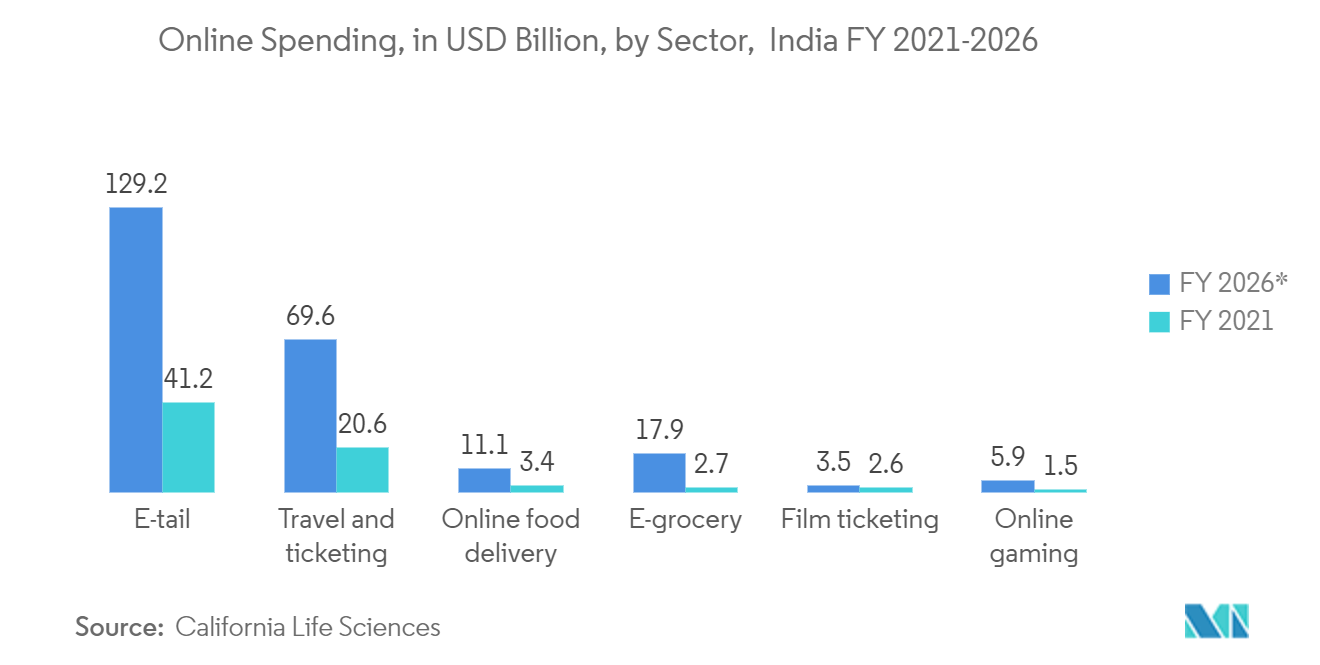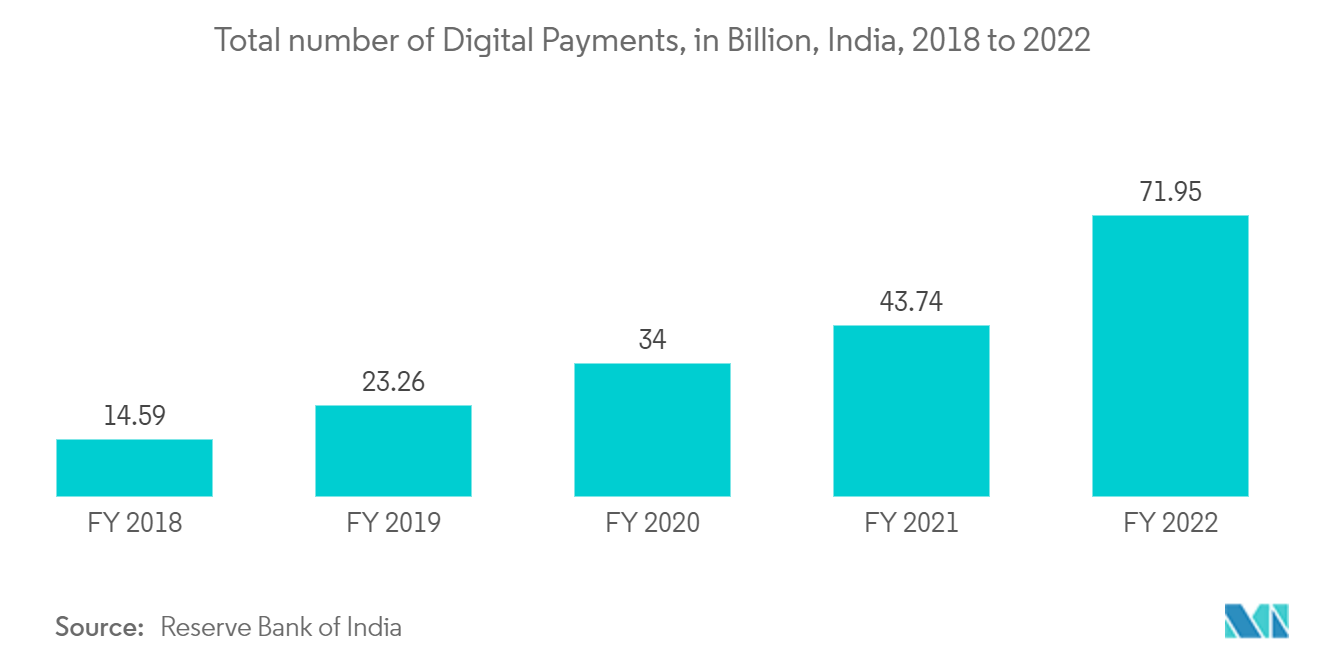Market Trends of India Mobile Payments Industry
Booming E-Commerce Sector Propelling the India Mobile Wallet Market Growth
- In India's retail industry, luxury shopping is progressively gaining traction. As travel has grown more constrained and offline shopping has lost its shine, established enterprises, such as Darveys, in India have become the new luxury sanctuary for fashion shoppers. The shift from offline to online shopping has increased the sales of luxury online players; consumers are still looking forward to trying new ways to get their hands on luxury and rare things. For instance, According to IBEF, the Indian e-commerce market is expected to grow to USD 200 billion by 2026. There is a significant demand for international brands and foreign products among digitally connected Indian shoppers, creating substantial orders for advanced automated warehouses to handle the increased inflow of general merchandise volumes. Such a rise in online shopping is expected to drive the studied market.
- The government encouraged the MSMEs to market their products on the E-commerce site and through the Government e-Marketplace (GeM), which is run and owned by the government. Many Ministries and PSUs (public sector undertakings) source their procurement from GeM. As of July 14, 2022, according to the Indian Brand Equity Foundation, the GeMportal had served about 10.55 million orders worth INR 266,533 crores (USD 33.28 billion) from 4.73 million registered service providers and sellers for 61,208 buyer organizations.
- The Government e-Marketplace (GeM) platform provided 60,632 customers with 10.35 million orders of Rs. 258,359 crores (USD 33.07 billion) from 4.56 million registered sellers and service providers in June 2022. The Department for Promotion of Industry and Internal Trade (DPIIT) is reportedly planning to use the Open Network for Digital Commerce (ONDC) to establish protocols for cataloging, vendor discovery, and price discovery in an effort to systematize the onboarding process of retailers on e-commerce platforms. For the nation's and its citizens' greater benefit, the department seeks to give all market participants equitable chances to utilize the e-commerce ecosystem to its fullest potential.
- According to California Life Sciences. Indians spent more than USD 41 billion on e-commerce in the fiscal year 2021. This was predicted to exceed USD 129 billion by the fiscal year 2026. Total online consumption is predicted to rise from 72 billion dollars in 2021 to more than 237 billion dollars in the fiscal year 2026. These are expected to create an opportunity for the local and international players to develop new solutions to capture the market share.
- Over the past few years, several technology start-ups specializing in the financial segment have emerged, disrupting how we make purchases. For instance, in India, from app-based wallets and Aadhaar/UPI-linked instant transactions to single-window e-commerce apps, fintech start-ups need to be mindful of the threats and invest in creating a robust data security framework for the apps. This needs to be addressed as these may be boot-strapped start-ups and generally avoid the hefty investment needed for a more than essential digitally secure ecosystem. This needs to be addressed by collaboration with cybersecurity firms that provide customized and value-driven services against the big-budget packages.

Proximity Payment is Expected to Hold Major Market Share
- Proximity payment uses Near Field Communication (NFC) technology for payment facilitation. It consists of a small antenna within a smartphone that allows bi-directional communication with NFC readers (contactless POS) to perform contactless payment transactions. Its adoption is favored by the growing NFC-enabled smartphone base and by the already established underlying POS infrastructure supporting contactless credit/debit cards.
- By developing a user-friendly app for the same, Apple is adopted widely. The attempt made the registration easy by clicking a picture of the contactless card. And availability over the phone or smartwatch enables swift payments over the terminal. The company also has been able to surpass the other payment forms available in the US (Starbucks, Android Pay, etc.) from the spread of new point-of-sale (POS) systems that work with the NFC signals Apple Pay functions on.
- Proximity mobile-based payment depends on the vast majority of new smartphones being equipped with an NFC chip and an increasing number of outlets. The mainstream usage of such technology will enable consumers to purchase goods and services directly at the point of sale using their mobile phones. Further, the COVID-19 impact is a potential way for NFC-based contactless payments as it will reduce the need to touch a payment terminal physically. Also, shops in Denmark are encouraging customers to pay with contactless methods instead of cash, alongside government officials mandating contactless and mobile payments to slow the spread of disease.
- Retailers, in addition, are required to decide on the mobile payment solution to adopt and support based on the relative ease of adoption and use for customers and on the ease of implementation for the retailer. The overall retail industry observes that the global population with the younger generation of smartphone-enabled consumers are among the prime drivers demanding shopping convenience in-store as they enjoy online.
- According to the Reserve Bank of India, in the last year, acceptance of the BHIM UPI QR code had increased by approximately 128 million in India. BHIM is a payment software created by the National Payments Corporation of India to facilitate simple transactions over the Unified Payment Interface. Such gradual growth is expected to drive the studied market over the forecasted period. In the last financial year, around 71 billion digital payments were recorded across India. This was a significant increase compared to the previous three years.


